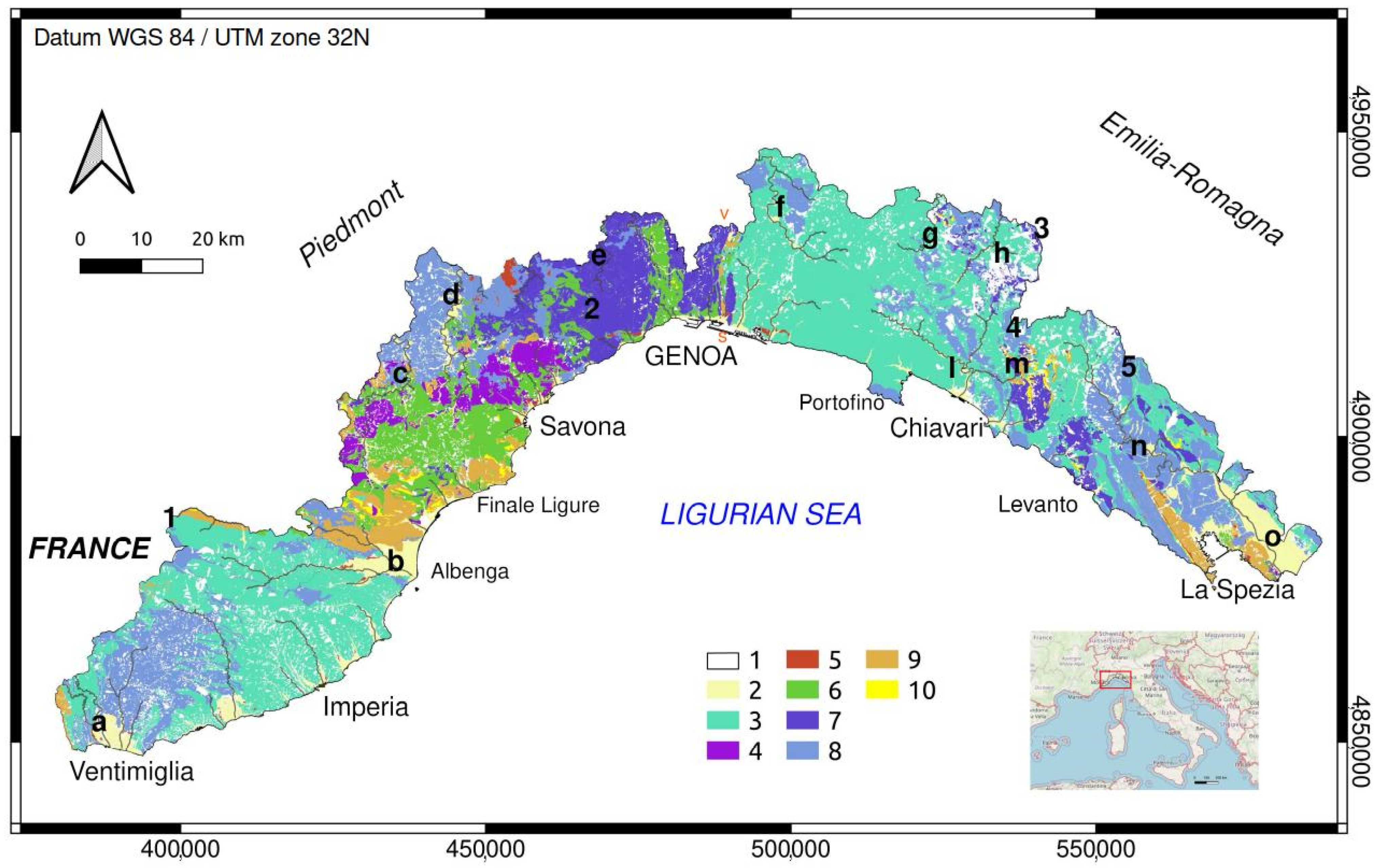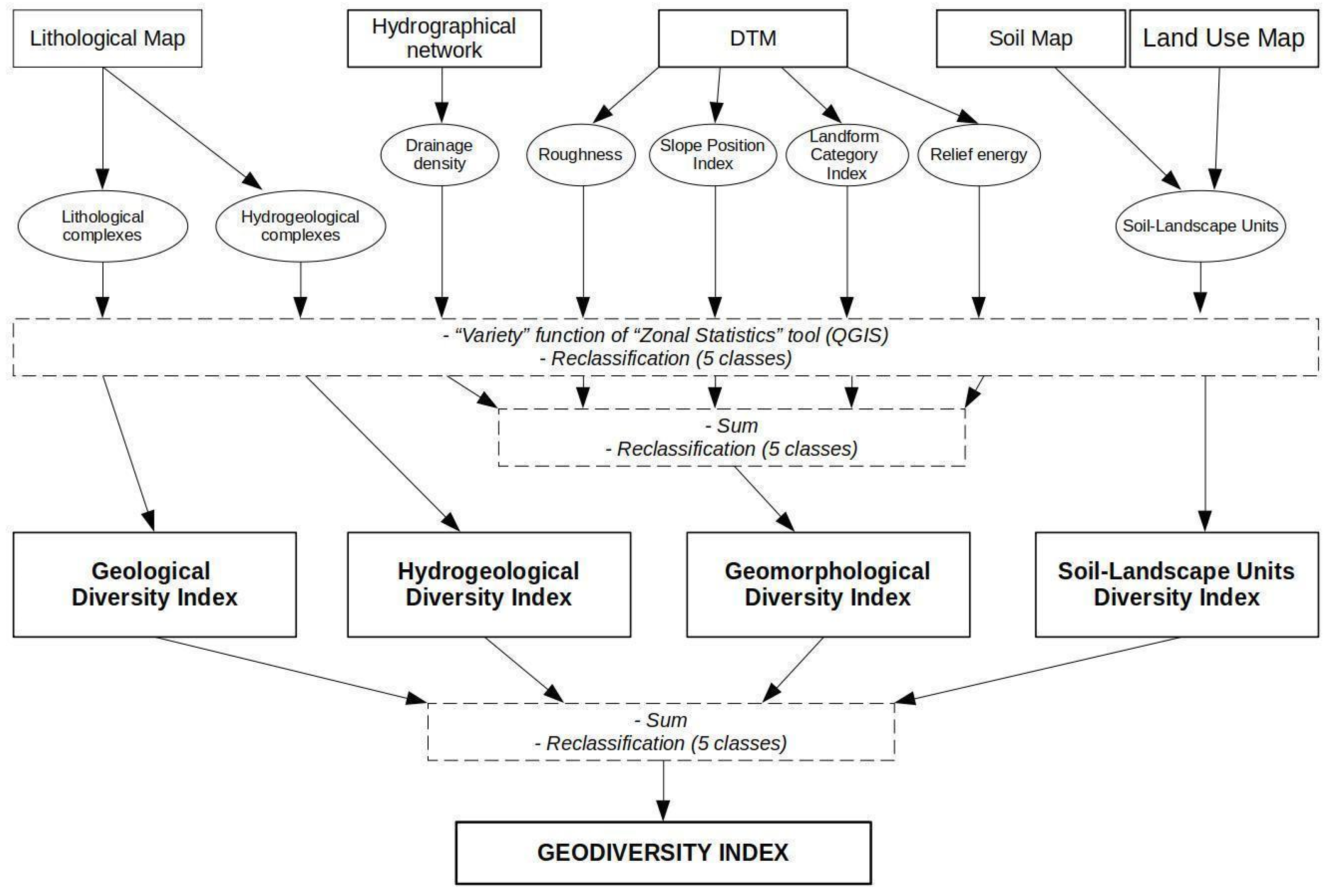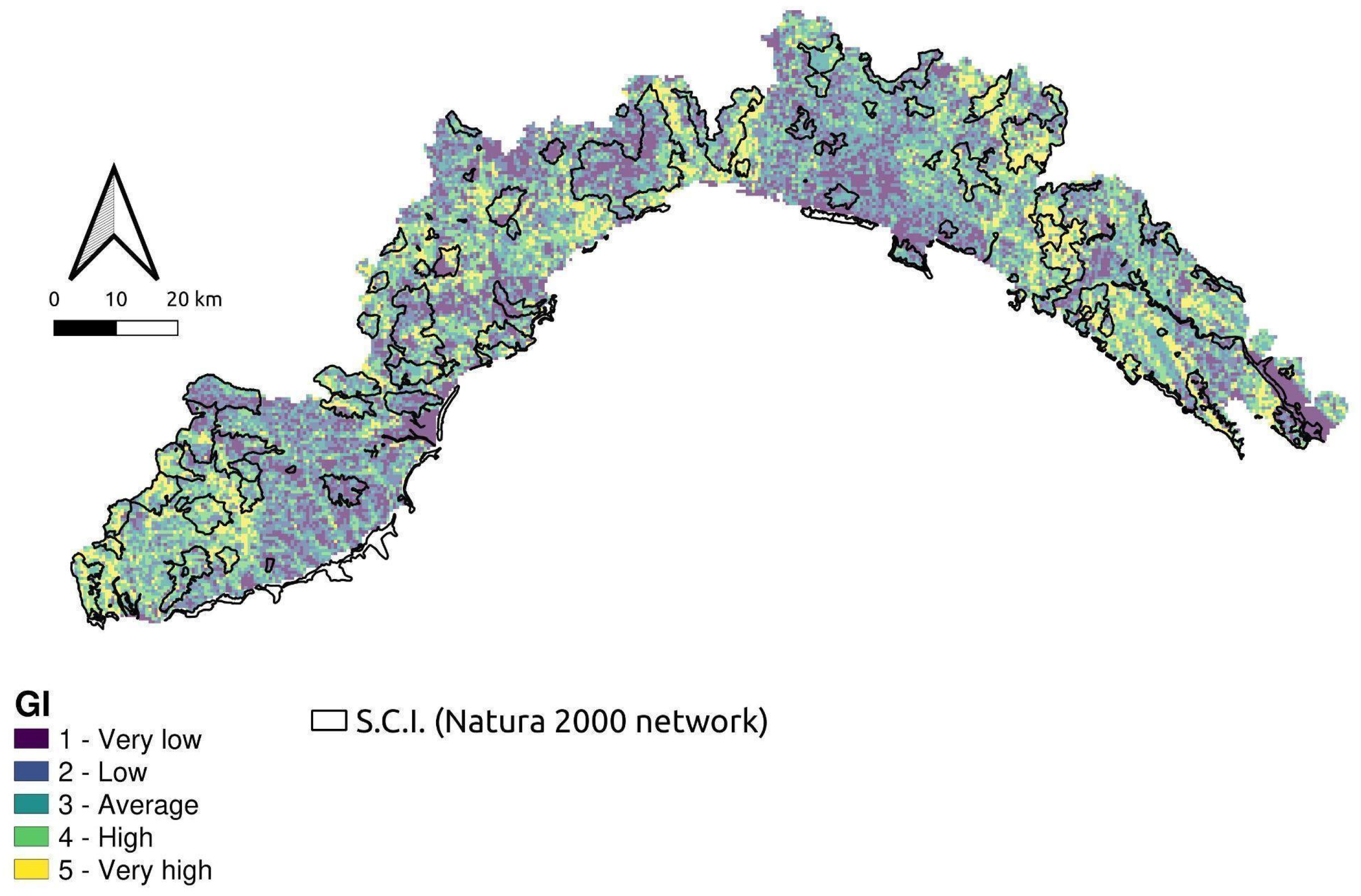A Quantitative GIS and AHP Based Analysis for Geodiversity Assessment and Mapping
Abstract
:1. Introduction
2. Landscapes and Landforms of Liguria
3. Materials and Methods
3.1. Input Data for the Calculation of the Diversity Indices
3.2. Analytic Hierarchy Process (AHP)
3.3. Cohen’s k Comparison
4. Results
5. Discussion
6. Conclusions
Author Contributions
Funding
Institutional Review Board Statement
Informed Consent Statement
Conflicts of Interest
References
- Wiedenbein, F.W. Ein Geotopschutzkonzept für Deutschland. In Geotopschutz Probleme: Der Methodik und der Praktischen; University of Saarland: Saarbrucken, Germany, 1993. [Google Scholar]
- Sharples, C. Geoconservation in forest management-principles and procedures. Tasforest 1995, 7, 37–50. [Google Scholar]
- Eberhard, R. Pattern & Process: Towards a Regional Approach to National Estate Assessment of Geodiversity; Australian Heritage Commission: Camberra, Australia, 1997. [Google Scholar]
- Johansson, C.E. Geodiversitet i Nordisk Naturvård; Nordisk Ministerråad: Copenhagen, Denmark, 2000. [Google Scholar]
- Stanley, M. Editorial. Geodivers. Update 2001, 1, 1. [Google Scholar]
- Nieto, L.M. Geodiversidad: Propuesta de una definition integradora. Bol. Geol. Min. 2001, 112, 3–12. [Google Scholar]
- Australian Heritage Commission. Australian Natural Heritage Charter; Australian Heritage Commission: Canberra, Australia, 2002. [Google Scholar]
- Kozlowski, S. Geodiversity. The concept and scope of geodiversity. Prz. Geol. 2004, 52, 833–837. [Google Scholar]
- Serrano, E.; Ruiz-Flaňo, P. Geodiversity. A theoretical and applied concept. Geogr. Helv. 2007, 62, 140–147. [Google Scholar] [CrossRef]
- Gray, M. Geodiversity: Valuing and Conserving Abiotic Nature, 1st ed.; Wiley, J., Ed.; The Atrium, Southern Gate: Chichester, UK, 2004. [Google Scholar]
- Zwoliński, Z.; Najwer, A.; Giardino, M. Methods for assessing geodiversity. In Geoheritage: Assessment, Protection and Management; Reynard, E., Brilha, J., Eds.; Elsevier: Amsterdam, The Netherlands, 2018; pp. 27–52. [Google Scholar] [CrossRef]
- Pellitero, R.; Manosso, F.C.; Serrano, E. Mid- and large-scale geodiversity calculation in Fuentes Carrionas (NW Spain) and Serra do Cadeado (Paraná, Brazil): Methodology and application for land management. Geogr. Ann. Ser. A Phys. Geogr. 2014, 97, 219–235. [Google Scholar] [CrossRef]
- Panizza, M. The geomorphodiversity of the Dolomites (Italy): A key to geoheritage assessment. Geoheritage 2009, 1, 33–42. [Google Scholar] [CrossRef] [Green Version]
- JNCC. Common Standards Monitoring Guidance for Earth Science Sites; JNCC: Peterborough, UK, 2004. [Google Scholar]
- Gray, M. Geodiversity: Developing the paradigm. Proc. Geol. Assoc. 2008, 119, 287–298. [Google Scholar] [CrossRef]
- Holt-Wilson, T. Norfolk’s Earth Heritage: Valuing Our Geodiversity; Norfolk Geodiversity Partnership: Norfolk, UK, 2010. [Google Scholar]
- Ellis, N. The Geological Conservation Review (GCR) in Great Britain—Rationale and methods. Proc. Geol. Assoc. 2011, 122, 353–362. [Google Scholar] [CrossRef]
- Bradbury, J. A keyed classification of natural geodiversity for land management and nature conservation purposes. Proc. Geol. Assoc. 2014, 125, 329–349. [Google Scholar] [CrossRef]
- Seijmonsbergen, A.C.; de Jong, M.G.G.; de Graff, L.W.S.; Anders, N.S. Geodiversität von Vorarlberg und Liechtenstein—Geodiversity of Vorarlberg and Liechtenstein; Haupt Verlag: Bern, Switzerland, 2014. [Google Scholar]
- Kot, R. The point bonitation method for evaluating geodiversity: A guide with examples (Polish Lowland). Geogr. Ann. Ser. A Phys. Geogr. 2015, 97, 375–393. [Google Scholar] [CrossRef] [Green Version]
- Hjort, J.; Luoto, M. Geodiversity of high-latitude landscapes in northern Finland. Geomorphology 2010, 115, 109–116. [Google Scholar] [CrossRef]
- Ruban, D.A. Quantification of geodiversity and its loss. Proc. Geol. Assoc. 2010, 121, 326–333. [Google Scholar] [CrossRef]
- Pellitero, R.; González-Amuchastegui, M.J.; Ruiz-Flaňo, P.; Serrano, E. Geodiversity and geomorphosite assessment applied to a natural protected area: The Ebro and Rudron Gorges Natural Park (Spain). Geoheritage 2011, 3, 163–174. [Google Scholar] [CrossRef]
- Pereira, D.I.; Pereira, P.; Brilha, J.; Santos, L. Geodiversity assessment of Paraná State (Brazil): An innovative approach. Environ. Manag. 2013, 52, 541–552. [Google Scholar] [CrossRef] [Green Version]
- De Paula Silva, J.; Pereira, D.I.; Agular, A.M.; Rodrigues, C. Geodiversity assessment of the Xingu drainage basin. J. Maps 2013, 9, 254–262. [Google Scholar] [CrossRef] [Green Version]
- De Paula Silva, J.; Rodrigues, C.; Pereira, D.I. Mapping and Analysis of Geodiversity Indices in the Xingu River Basin, Amazonia, Brazil. Geoheritage 2015, 7, 337–350. [Google Scholar] [CrossRef] [Green Version]
- Tukiainen, H.; Bailey, J.J.; Field, R.; Kangas, K.; Hjort, J. Combining geodiversity with climate and topography to account for threatened species richness. Conserv. Biol. 2016, 31, 364–375. [Google Scholar] [CrossRef]
- Araujo, A.M.; Pereira, D.I. A new methodological contribution for the Geodiversity assessment: Applicability to Ceará State (Brazil). Geoheritage 2018, 10, 591–605. [Google Scholar] [CrossRef]
- Perotti, L.; Carraro, G.; Giardino, M.; de Luca, D.A.; Lasagna, M. Geodiversity Evaluation and Water Resources in the Sesia Val Grande UNESCO Geopark (Italy). Water 2019, 11, 2102. [Google Scholar] [CrossRef] [Green Version]
- Crisp, J.R.; Ellison, J.C.; Fischer, A. Current trends and future directions in quantitative geodiversity assessment. Progr. Phys. Geogr. 2020, 45, 514–540. [Google Scholar] [CrossRef]
- Zwoliński, Z. The routine of landform geodiversity map design for the Polish Carpathian Mts. In Geoecology of the Euroasiatic Alpids; Rojan, E., Łajczak, A., Eds.; Landform Analysis: Poznań, Poland, 2009; Volume 11, pp. 79–87. [Google Scholar]
- Benito-Calvo, A.; Pérez-González, A.; Magri, O.; Meza, P. Assessing regional geodiversity: The Iberian Peninsula. Earth Surf. Process. Landf. 2009, 34, 1433–1445. [Google Scholar] [CrossRef]
- Ferrero, E.; Giardino, M.; Lozar, F.; Giordano, E.; Belluso, E.; Perotti, L. Geodiversity action plans for the enhancement of geoheritage in the Piemonte region (north-western Italy). Ann. Geophys. 2012, 55, 487–495. [Google Scholar] [CrossRef]
- Panizza, M.; Piacente, S. Cultural geomorphology and geodiversity. In Geomorphosites; Reynard, E., Coratza, P., Regolini-Bissig, G., Eds.; Verlag Dr. Friedrich Pfeil: Munich, Germany, 2009. [Google Scholar]
- Gordon, J.E. Rediscovering a sense of wonder: Geoheritage, geotourism and cultural landscape experiences. Geoheritage 2012, 4, 65–77. [Google Scholar] [CrossRef]
- Li, W.; Zhu, J.; Fu, L.; Zhu, Q.; Xie, Y.; Hu, Y. An augmented representation method of debris flow scenes to improve public perception. Int. J. Geogr. Inf. Sci. 2021, 35, 1521–1544. [Google Scholar] [CrossRef]
- Quesada-Román, A.; Pérez-Umaña, D. State of the Art of Geodiversity, Geoconservation, and Geotourism in Costa Rica. Geosciences 2020, 10, 211. [Google Scholar] [CrossRef]
- Ilic, M.; Stojković, S.; Rundić, L.; Calic, J.; Sandić, D. Application of the geodiversity index for the assessment of geodiversity in urban areas: An example of the Belgrade City area, Serbia. Geol. Croat. 2016, 69, 325–336. [Google Scholar] [CrossRef]
- Santos, D.; Mansur, K.; Gonçalves, J.; Arruda, E.; Manosso, F. Quantitative assessment of geodiversity and urban growth impacts in Armação dos Búzios, Rio de Janeiro, Brazil. Appl. Geogr. 2017, 85, 184–195. [Google Scholar] [CrossRef]
- Saaty, T.L. A scaling method for priorities in hierarchical structures. J. Math. Psychol. 1977, 15, 234–281. [Google Scholar] [CrossRef]
- Saaty, T.L. The Analytic Hierarchy Process; McGraw-Hill: New York, NY, USA, 1980. [Google Scholar]
- Köppen, W. Das geographische System der Klimate. In Handbuch der Klimatologie; Köppen, W., Geiger, R., Eds.; Borntraeger: Berlin, Germany, 1936. [Google Scholar]
- Giammarino, S.; Capponi, G.; Crispini, L.; Giglia, G.; Piazza, M. Carta Geologica Della Liguria—Scala 1:200,000; LAC: Firenze, Italy, 2002. [Google Scholar]
- Boni, P.; Mosna, S.; Vanesi, M. La Pietra di Finale (Liguria Occidentale). Atti Ist. Geol. Univ. Pavia 1968, 18, 102–150. [Google Scholar]
- Fanucci, F.; Nosengo, S. Rapporti fra neotettonica e fenomeni morfogenetici del versante marittimo dell’Appennino Ligure e del margine continentale. Ital. J. Geosci. 1977, 96, 41–51. [Google Scholar]
- Brancucci, G.; Paliaga, G. Geomorphic characterization of the main drainage basins of maritime Liguria (Italy)—Preliminary results. Geogr. Fis. Din. Quat. 2005, 7, 59–67. [Google Scholar]
- Paliaga, G.; Faccini, F.; Luino, F.; Turconi, L.; Bobrowsky, P. Geomorphic processes and risk related to a large landslide dam in a highly urbanized Mediterranean catchment (Genova, Italy). Geomorphology 2019, 327, 48–61. [Google Scholar] [CrossRef]
- Progetto IFFI (Inventario dei Fenomeni Franosi in Italia) [Inventory of Landslide Phenomena in Italy]. Available online: https://www.isprambiente.gov.it/it/progetti/cartella-progetti-in-corso/suolo-e-territorio-1/iffi-inventario-dei-fenomeni-franosi-in-italia (accessed on 17 January 2021).
- Brandolini, P.; Faccini, F.; Paliaga, G.; Piana, P. Man-made landforms survey and mapping of an urban historical center in a coastal mediterranean environment. Geogr. Fis. Dinam. Quat. 2018, 41, 23–34. [Google Scholar] [CrossRef]
- Brandolini, P.; Cappadonia, C.; Luberti, G.M.; Donadio, C.; Stamatopoulos, L.; Di Maggio, C.; Faccini, F.; Stanislao, C.; Vergari, F.; Paliaga, G.; et al. Geomorphology of the Anthropocene in Mediterranean urban areas. Prog. Phys. Geogr. 2019, 44, 461–494. [Google Scholar] [CrossRef]
- Paliaga, G.; Faccini, F.; Luino, F.; Roccati, A.; Turconi, L. A clustering classification of catchment anthropogenic modification and relationships with floods. Sci. Total Environ. 2020, 740, 139915. [Google Scholar] [CrossRef]
- Mastronuzzi, G.; Aringoli, D.; Aucelli, P.; Baldassarre, A.; Bellotti, P.; Bini, M.; Biolchi, S.; Bontempi, S.; Brandolini, P.; Chelli, A.; et al. Geomorphological map of the Italian coast: From a descriptive to a morphodynamic approach. Geogr. Fis. Dinam. Quat. 2017, 40, 161–195. [Google Scholar] [CrossRef]
- Faccini, F.; Benedettini, A.; Firpo, M.; Perasso, L.; Poggi, F. Land-management and planning in karst areas: The ligurian case-study (Italy). Rend. Online Soc. Geol. Ital. 2012, 21, 611–613. [Google Scholar]
- Gestionale Speleologico Ligure [Ligurian Speleological Management]. Available online: https://www.catastogrotte.net/liguria/index.php (accessed on 6 May 2021).
- Paliaga, G.; Luino, F.; Turconi, L.; De Graff, J.V.; Faccini, F. Terraced landscapes on Portofino Promontory (Italy): Identification, geo-hydrological hazards and management. Water 2020, 12, 20. [Google Scholar] [CrossRef] [Green Version]
- Burlando, M.; Firpo, M.; Queirolo, C.; Rovere, A.; Vacchi, M. From geoheritage to sustainable development: Strategies and perspectives in the Beigua Geopark (Italy). Geoheritage 2011, 3, 63–72. [Google Scholar] [CrossRef]
- Faccini, F.; Roccati, A.; Firpo, M. Geohiking map of Mt. Penna and Mt. Aiona area (Aveto Park, Liguria). J. Maps 2012, 8, 293–303. [Google Scholar] [CrossRef] [Green Version]
- Marchesini, M.; Pagano, R. The Val Graveglia manganese district. Mineral. Rec. 2001, 32, 349–379. [Google Scholar]
- Faccini, F.; Paliaga, G.; Piana, P.; Gabellieri, N.; Angelini, S.; Coratza, P. The Geoheritage map of the Portofino Natural Park (Italy) as a tool for the management of a highly frequented protected area. J. Maps 2018, 14, 87–96. [Google Scholar] [CrossRef]
- Brandolini, P.; Faccini, F.; Piccazzo, M.; Robbiano, A. Geomorphology, Environmental geology and natural-cultural heritage of Palmaria, Tino and Tinetto islands (Portovenere Park, Italy). Mem. Descr. Carta Geol. D’italia 2009, 87, 15–28. [Google Scholar]
- Agnoletti, M.; Errico, A.; Santoro, A.; Dani, A.; Preti, F. Terraced Landscapes and Hydrogeological Risk. Effects of Land Abandonment in Cinque Terre (Italy) during Severe Rainfall Events. Sustainability 2019, 11, 235. [Google Scholar] [CrossRef] [Green Version]
- Melelli, L.; Vergari, F.; Liucci, L.; Del Monte, M. Geomorphodiversity index: Quantifying the diversity of landforms and physical landscape. Sci. Total Environ. 2017, 584, 701–714. [Google Scholar] [CrossRef] [PubMed]
- Bétard, F.; Peulvast, J.-P. Geodiversity hotspots: Concept, method and cartographic application for geoconservation purposes at a regional scale. Env. Manag. 2019, 63, 822–834. [Google Scholar] [CrossRef] [PubMed]
- Nobre da Silva, M.L.; Leite do Nascimento, M.A.; Leite Mansur, K. Quantitative assessments of geodiversity in the area of the Seridó Geopark project, Northeast Brazil: Grid and centroid analysis. Geoheritage 2019, 11, 1177–1186. [Google Scholar] [CrossRef]
- Menezes dos Santos, F.; de la Corte Bacci, D.; Saad, A.R.; da Silva Ferreira, A.T. Geodiversity index weighted by multivariate statistical analysis. Appl. Geomat. 2020, 12, 361–370. [Google Scholar] [CrossRef]
- Jenks, G.F. The data model concept in statistical mapping. Int. Yearb. Cartogr. 1967, 7, 186–190. [Google Scholar]
- Ligurian Regional Geoportal: Lithological Map of Liguria. Available online: https://srvcarto.regione.liguria.it/geoviewer2/pages/apps/geoportale/index.html?id=1907 (accessed on 7 May 2021).
- Ligurian Regional Geoportal: Hydrographical Network and Drainage Basins. Available online: https://srvcarto.regione.liguria.it/geoviewer2/pages/apps/geoportale/index.html?id=2070 (accessed on 7 May 2021).
- Ligurian Regional Geoportal: Digital Terrain Model, ed. 2017. Available online: https://srvcarto.regione.liguria.it/geoviewer2/pages/apps/geoportale/index.html?id=2056 (accessed on 7 May 2021).
- Riley, S.J.; DeGloria, S.D.; Elliot, R. A terrain ruggedness index that quantifies topographic heterogeneity. Int. J. Sci. 1999, 5, 23–27. [Google Scholar]
- Weiss, A. Topographic Position and Landform Analysis. In Proceedings of the ESRI User Conference, San Diego, CA, USA, 9–13 July 2001. [Google Scholar]
- L’Abate, G.; Costantini, E.; Barbetti, R.; Fantappiè, M.; Lorenzetti, R.; Magini, S. Carta dei Suoli D’italia 1:1,000,000 (Soil Map of Italy, Scale 1:1,000,000); Società geográfica: Firenze, Italy, 2015. [Google Scholar] [CrossRef]
- Pourghasemi, H.R.; Pradhan, B.; Gokceoglu, C. Application of fuzzy logic and analytical hierarchy process (AHP) to landslide susceptibility mapping at Haraz watershed, Iran. Nat. Hazards 2012, 63, 965–996. [Google Scholar] [CrossRef]
- Kaliraj, S.; Chandrasekar, N.; Magesh, N.S. Identification of potential groundwater recharge zones in Vaigai upper basin, Tamil Nadu, using GIS-based analytical hierarchical process (AHP) technique. Arab. J. Geosci. 2014, 7, 1385–1401. [Google Scholar] [CrossRef]
- Roccati, A.; Paliaga, G.; Luino, F.; Faccini, F.; Turconi, L. GIS-Based Landslide Susceptibility Mapping for Land Use Planning and Risk Assessment. Land 2021, 10, 162. [Google Scholar] [CrossRef]
- Saaty, T.L.; Vargas, L.G. Models, Methods, Concepts and Applications of the Analytic Hierarchy Process; Springer Science & Business Media: New York, NY, USA, 2012; p. 175. [Google Scholar]
- Shannon, C. A mathematical theory of communication. Bell. Syst. Tech. J. 1948, 27, 623–656. [Google Scholar] [CrossRef]
- Jost, L. Partitioning diversity into independent alpha and beta components. Ecology 2007, 88, 2427–2439. [Google Scholar] [CrossRef] [Green Version]
- Goepel, K.D. Implementing the Analytic Hierarchy Process as a Standard Method for Multi-Criteria Decision Making in Corporate Enterprises—A New AHP Excel Template with Multiple Inputs. In Proceedings of the International Symposium on the Analytic Hierarchy Process, Kuala Lampur, Malaysia, 23–26 June 2013; No. 10. Creative Decisions Foundation: Kuala Lampur, Malaysia, 2013; Volume 2, pp. 1–10. [Google Scholar]
- Van Vliet, J.; Bregt, A.K.; Hagen-Zanker, A. Revisiting Kappa to account for change in the accuracy assessment of land-use change models. Ecol. Model. 2011, 222, 1367–1375. [Google Scholar] [CrossRef]
- Baeza, C.; Lantada, N.; Amorim, S. Statistical and spatial analysis of landslide susceptibility maps with different classification systems. Environ. Earth Sci. 2016, 75, 1318. [Google Scholar] [CrossRef] [Green Version]
- Visser, H.; de Nijs, T. The Map Comparison Kit. Environ. Model. Softw. 2006, 21, 346–358. [Google Scholar] [CrossRef]
- Ferrando, A.; Faccini, F.; Poggi, F.; Coratza, P. Geosites Inventory in Liguria Region (Northern Italy): A Tool for Regional Geoconservation and Environmental Management. Sustainability 2021, 13, 2346. [Google Scholar] [CrossRef]
- Brandolini, P.; Faccini, F.; Robbiano, A.; Bulgarelli, F. Geomorphology and cultural heritage of the Ponci Valley (Finalese karstic area, Ligurian Alps). Geogr. Fis. Dinam. Quat. 2011, 34, 65–74. [Google Scholar]
- Coratza, P.; Vandelli, V.; Fiorentini, L.; Paliaga, G.; Faccini, F. Bridging terrestrial and marine geoheritage: Assessing geosites in Portofino Natural Park (Italy). Water 2019, 11, 2112. [Google Scholar] [CrossRef] [Green Version]
- Muellner-Riehl, A.N.; Schnitzler, J.; Kissling, W.D.; Mosbrugger, V.; Rijsdijk, K.F.; Seijmonsbergen, A.C.; Versteegh, H.; Favre, A. Origins of global mountain plant biodiversity: Testing the ‘mountain-geobiodiversity hypothesis’. J. Biogeogr. 2019, 46, 2826–2838. [Google Scholar] [CrossRef] [Green Version]







| Scale | Degree of Preference | Description |
|---|---|---|
| 1 | Equally | Two factors contribute equally to the objective |
| 3 | Moderately | Experience and judgment slightly to moderately favour one factor over another |
| 5 | Strongly | Experience and judgment strongly or essentially favour one factor over another |
| 7 | Very strongly | A factor is strongly favoured over another and its dominance is showed in practice |
| 9 | Extremely | The evidence of favouring one factor over another is of the highest degree possible of an affirmation |
| 2, 4, 6, 8 | Intermediate | Used to represent compromises between the preferences in weights 1, 3, 5, 7 and 9 |
| Reciprocals | Opposite | Used for inverse comparison |
| Criteria | Weight (%) | Error (%) |
|---|---|---|
| Geomorphology | 35.5 | 3.3 |
| Lithology | 47.7 | 4.5 |
| Hydrogeology | 9.0 | 0.4 |
| Land Use | 7.8 | 0.6 |
| Class | Very High | High | Average | Low | Very Low |
|---|---|---|---|---|---|
| Kappa | 0.784 | 0.447 | 0.435 | 0.807 | 1 |
| GI Class | Total Area (km2) | Area within S.C.I. (km2) | Area within S.C.I. (%) |
|---|---|---|---|
| Class 1: Very low | 1087.5 | 271.2 | 24.94 |
| Class 2: Low | 1247.2 | 286.5 | 22.97 |
| Class 3: Average | 1113.5 | 266.5 | 23.93 |
| Class 4: High | 1311.8 | 350 | 26.68 |
| Class 5: Very high | 657.7 | 225.3 | 34.25 |
| All classes (entire Liguria region) | 5417.7 | 1399.5 | 25.83 |
Publisher’s Note: MDPI stays neutral with regard to jurisdictional claims in published maps and institutional affiliations. |
© 2021 by the authors. Licensee MDPI, Basel, Switzerland. This article is an open access article distributed under the terms and conditions of the Creative Commons Attribution (CC BY) license (https://creativecommons.org/licenses/by/4.0/).
Share and Cite
Ferrando, A.; Faccini, F.; Paliaga, G.; Coratza, P. A Quantitative GIS and AHP Based Analysis for Geodiversity Assessment and Mapping. Sustainability 2021, 13, 10376. https://doi.org/10.3390/su131810376
Ferrando A, Faccini F, Paliaga G, Coratza P. A Quantitative GIS and AHP Based Analysis for Geodiversity Assessment and Mapping. Sustainability. 2021; 13(18):10376. https://doi.org/10.3390/su131810376
Chicago/Turabian StyleFerrando, Andrea, Francesco Faccini, Guido Paliaga, and Paola Coratza. 2021. "A Quantitative GIS and AHP Based Analysis for Geodiversity Assessment and Mapping" Sustainability 13, no. 18: 10376. https://doi.org/10.3390/su131810376
APA StyleFerrando, A., Faccini, F., Paliaga, G., & Coratza, P. (2021). A Quantitative GIS and AHP Based Analysis for Geodiversity Assessment and Mapping. Sustainability, 13(18), 10376. https://doi.org/10.3390/su131810376









